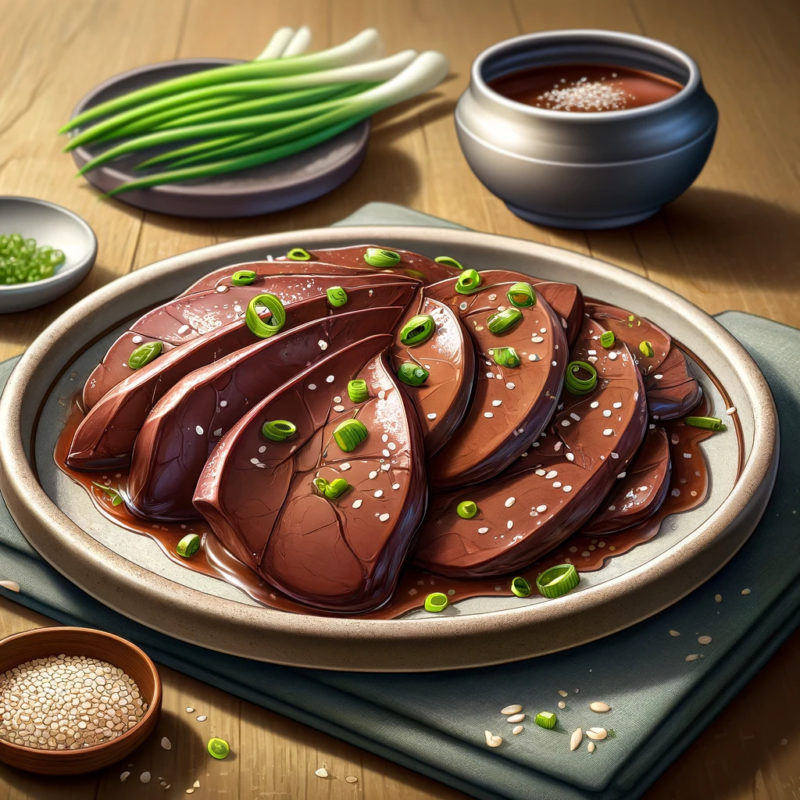Exploring the Best Tasting South Korean Dishes: A Culinary Journey (Part 6)
South Korean cuisine is a vibrant symphony of flavors, each dish a testament to the nation’s rich culinary heritage. Known for its bold, intense flavors and diverse ingredients, Korean food offers a tantalizing array of tastes that are both intriguing and satisfying. Whether you’re dining in the bustling streets of Seoul or the comfort of your home, these dishes provide a culinary experience that’s hard to forget.
1. Jogaegui (조개구이): Savoring the Sea’s Bounty in Korean Style
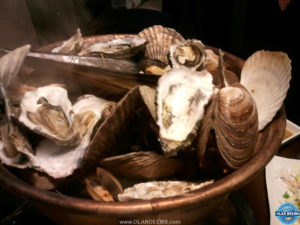
Jogaegui (조개구이)
Jogaegui, a popular Korean dish, showcases the simplicity and elegance of grilling as a cooking technique to enhance the natural flavors of seafood. This dish primarily features various types of shellfish such as clams, mussels, oysters, and scallops, which are grilled over an open flame, allowing the subtle sea flavors to shine through beautifully.
The preparation of Jogaegui is straightforward yet requires a meticulous approach to preserve the delicate textures and flavors of the shellfish. The seafood is typically cleaned thoroughly and then grilled shell-on. As they cook, the shells open up, indicating they are ready to be enjoyed. The high heat from the grill imparts a slightly smoky flavor to the shellfish, enhancing its natural saltiness and sweetness.
Jogaegui is often enjoyed as both an appetizer and a main dish, making it a versatile option for various dining settings. It is usually served with a side of tangy and spicy dipping sauces, such as soy sauce with vinegar and chili, which complement the sweetness of the seafood. Additionally, diners can squeeze fresh lemon juice over the grilled shellfish to add a zesty note that elevates the overall flavor profile.
In Korea, Jogaegui is not just a meal; it’s a communal experience, often enjoyed at outdoor gatherings or at specialized seafood restaurants where diners can select their preferred shellfish to be grilled to perfection. This communal aspect makes Jogaegui a favorite choice for social gatherings, where the act of sharing food enhances the dining experience.
The health benefits of Jogaegui are notable as well. Shellfish are low in fat and high in protein, making them a nutritious option. They are also rich in minerals such as zinc and iron, which are essential for overall health.
Jogaegui offers a culinary journey that is both flavorful and healthful, providing a taste of Korea’s rich coastal cuisine. Whether enjoyed on a breezy seaside or in a bustling city center, Jogaegui is a delightful way to savor the bounty of the sea, Korean style.
2. Andong Jjimdak (안동찜닭): A Flavorful Journey Through Korean Culinary Tradition
Andong Jjimdak, a signature dish from the city of Andong in South Korea, offers a rich tapestry of flavors that are deeply rooted in Korean culinary tradition. This hearty chicken stew is renowned for its combination of savory, sweet, and slightly spicy elements, making it a favorite among those who appreciate depth in their dishes.
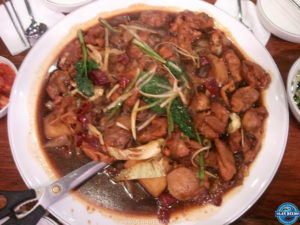 The main ingredient in Andong Jjimdak is chicken, which is typically cut into pieces and simmered with an assortment of vegetables such as potatoes, carrots, and onions. What sets this dish apart is the inclusion of dangmyeon (sweet potato noodles), which absorb the flavors of the stew and contribute a unique texture.
The main ingredient in Andong Jjimdak is chicken, which is typically cut into pieces and simmered with an assortment of vegetables such as potatoes, carrots, and onions. What sets this dish apart is the inclusion of dangmyeon (sweet potato noodles), which absorb the flavors of the stew and contribute a unique texture.
The sauce for Andong Jjimdak is a meticulous blend of soy sauce, garlic, and sugar, enhanced by a touch of ginger and a hint of Korean chili paste or dried chilies, which introduce a subtle heat to the dish. This creates a rich, umami-packed sauce that clings to every ingredient, infusing the entire dish with an irresistible flavor.
Traditionally, Andong Jjimdak is garnished with sesame seeds and sliced green onions, which add a fresh contrast to the stew’s robust flavors. The dish is served family-style, often in the center of the table, encouraging a communal dining experience that is central to Korean food culture.
Andong Jjimdak is not only a celebration of flavors but also a culinary reflection of Andong’s regional history and cultural heritage. It was originally developed in the 1980s as a specialty dish to attract tourists to the area and has since become a beloved part of Korean cuisine, both in its hometown and across the country.
This dish’s rich flavors and comforting nature make it particularly popular during the cooler months, but it is enjoyed year-round by those seeking a substantial and satisfying meal. Andong Jjimdak exemplifies the harmony and balance of Korean cooking, making it a must-try for anyone wanting to explore the diversity of Korea’s culinary landscape.
3. Gomtang (곰탕): A Rich Tradition of Korean Beef Bone Soup
Gomtang, also known as Gomguk, is a quintessential Korean soup that epitomizes the deep, comforting flavors traditional to Korean cuisine. This hearty soup is slow-simmered, drawing rich flavors from beef bones, such as ribs, oxtail, brisket, or even ox’s head. The result is a broth that is both milky in appearance and robust in taste, offering a nourishing meal that warms from the inside out.
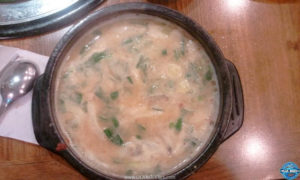
Gomtang (곰탕)
The preparation of Gomtang involves a meticulous slow-cooking process where the bones are simmered for several hours. This not only allows the marrow to infuse the broth with flavor but also ensures that the collagen breaks down, giving the soup its characteristic creamy texture. The simmering process is carefully managed to maintain a clear broth, while achieving the milky color that is a hallmark of Gomtang.
Traditionally, Gomtang is seasoned minimally, relying on the quality of the ingredients and the cooking method to bring out the natural flavors. It is typically served with rice, which is either added into the soup or served on the side, allowing the subtle flavors of the broth to be enjoyed without overpowering seasonings. Green onions and salt are often provided on the side, allowing diners to adjust the taste to their preference.
Gomtang is more than just a meal; it is a part of Korean culinary heritage that reflects the philosophy of using simple ingredients to create deeply satisfying dishes. It is commonly enjoyed during the colder months, as its rich broth is believed to help fortify the body against the cold. Additionally, Gomtang is often served during special occasions and to convalescing individuals
4. Bokkeumbab (볶음밥): The Versatile Korean Fried Rice
Bokkeumbab, which translates to fried rice in Korean, is a versatile and popular dish in Korean cuisine. Known for its delightful flavors and the ability to incorporate a variety of leftovers, Bokkeumbab is not only a delicious meal but also a practical approach to minimizing food waste. This dish allows for endless customization, making it a favorite among those who enjoy tailoring their meals to their specific tastes.
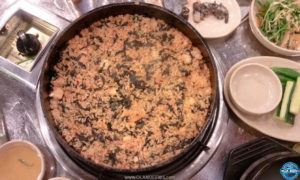
Bokkeumbab (볶음밥)
The basic preparation of Bokkeumbab involves stir-frying cooked rice with a mix of ingredients such as vegetables, eggs, and meats. Common additions include carrots, onions, green peas, and scallions, which provide a crunch and freshness to the dish. Proteins such as chicken, beef, or shrimp are often added, turning the fried rice into a hearty meal. The entire mixture is seasoned with soy sauce, sesame oil, and a hint of garlic, which lend rich and savory flavors that are distinctly Korean.
One of the unique aspects of Bokkeumbab is the inclusion of kimchi in some variations, known as Kimchi Bokkeumbab. The kimchi adds a spicy and tangy dimension that enhances the dish, making it even more flavorful and complex. This version of Bokkeumbab is particularly popular for its robust flavor profile and is often topped with a fried egg, whose runny yolk adds a creamy texture to the rice.
Bokkeumbab is not only a quick and easy dish to prepare but also a brilliant way to utilize leftovers, making it a staple in many Korean households. Whether it’s the end of the week’s remaining vegetables or last night’s barbecue, almost anything can be tossed in to create a new and exciting dish.
The dish is typically enjoyed on its own or with a side of pickled vegetables, providing a satisfying and balanced meal. It’s particularly favored for quick lunches or casual dinners, offering a filling and nutritious option that appeals to all age groups.
Bokkeumbab exemplifies the simplicity and ingenuity of Korean cooking, providing a delicious solution to the universal question of what to do with leftovers. With its customizable nature and delightful flavors, Bokkeumbab is a testament to the resourcefulness and culinary creativity of Korean cuisine.
5. Exploring the Richness of Bull Liver (소간) in Korean Cuisine
Bull liver, known as ‘Sogan’ in Korean, is a delicacy that is cherished for its nutritional value and distinctive flavor. This ingredient is often featured in various Korean dishes, showcasing the versatility and depth of traditional Korean cooking.
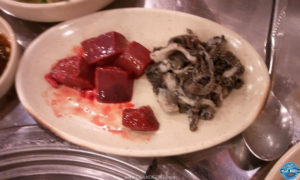
Bull Liver (소간)
Bull liver is highly regarded in Korean cuisine for its dense nutrient profile. Rich in iron, vitamin A, and essential proteins, it is considered a health booster, especially valuable in diets aimed at increasing energy and improving overall vitality. The texture of bull liver is tender yet firm, providing a unique mouthfeel that is appreciated by many culinary enthusiasts.
In Korean culinary practices, bull liver can be prepared in several ways. It is commonly sliced thinly and quickly seared or grilled, preserving its delicate texture and natural flavors. This method enhances the liver’s rich, earthy taste, making it a favorite among those who appreciate bold, distinct flavors.
Another popular preparation is marinating the liver in a mixture of soy sauce, garlic, sesame oil, and a touch of sugar. This not only tempers the intense flavor of the liver but also adds a sweet and savory complexity that balances the dish beautifully. The marinated liver can then be cooked on a hot grill or stir-fried, often accompanied by onions and green peppers which add freshness and a slight crunch.
Bull liver is also enjoyed raw in some traditional Korean settings, sliced thinly and served with a dipping sauce made from sesame oil and salt, or a spicy red chili paste. Eating the liver raw showcases its natural flavor and soft texture, providing a truly authentic experience.
The inclusion of bull liver in a meal highlights the Korean culinary tradition’s ability to utilize diverse ingredients to their fullest potential, creating dishes that are not only flavorful but also nutritionally beneficial. Whether grilled, stir-fried, or enjoyed raw, bull liver remains a testament to the rich culinary heritage and inventive spirit of Korean cuisine.
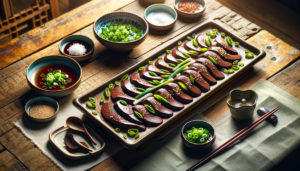
Liver of bull (소간)
Each of these dishes not only captures the essence of Korean flavors but also tells a story of cultural heritage and culinary innovation. Whether you’re seeking something tangy and spicy or a dish that marries sweet with savory, the best-tasting South Korean dishes are culinary masterpieces that promise not just a meal, but an unforgettable dining adventure.
So, immerse yourself in the rich flavors of South Korea and discover why its cuisine is celebrated worldwide. Each dish, a blend of tradition and taste, is waiting to leave a lasting impression on your palate. Don’t miss out on this opportunity to explore the depth and diversity of South Korean cuisine.
[ Read more… ]

